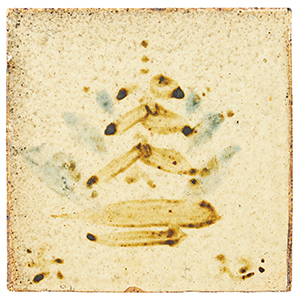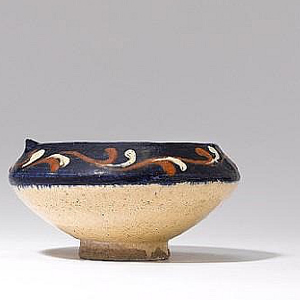Bernard Leach: Father of British Studio Pottery
Rightly revered as the father of British Studio pottery, Bernard Leach’s influence as a ceramicist is hard to overstate. As someone who exceeded his accolades, Leach’s pure and utilitarian form of pottery stood in opposition to mass production and had a lasting influence on modern design in North America during the 1950s and 1960s. It was his A Potter’s Book though that defined Leach’s craft philosophy and techniques, and created a legacy of influence on a wealth of future ceramicists.

Bernard Leach in 1953 (Wikimedia Commons)
Born in Hong Kong in 1887, Bernard Leach divided his early years between England, Japan, and China, before he found his calling to create and promote pottery that combined Western and Eastern arts and philosophies. Fusing traditional Korean, Japanese and Chinese pottery with techniques from England and Germany, like slipware and salt glaze ware, Leach espoused the principle that pottery is a combination of art, philosophy, design, and craft.
Leach embodied a new 20th century approach to life as an artist-potter, whose aesthetic style was characterised by functional pots that were hand-thrown and glazed in quiet, earthy colours. His ethical pots stood in opposition to mass-produced ceramics (or “commercial scientific graveyard” as he disparagingly referred to them) as his work placed modesty and simplicity at the fore.

Bernard Leach – pagoda tile. Sold for £240 via Lyon & Turnbull (April 2021)
Creating a cultural cross-pollination of East and West, Leach was the only non-Japanese founder of the Mingei folk art movement. Mingei celebrated hand-crafted production and regional materials. And after training for ten years in Japanese ceramics, Leach brought the aesthetic principles of Mingei back to the UK, but it was his time in the East that helped to hone his pure and utilitarian forms, with a particular focus on the raku technique. Such was his influence that his Mingei co-founder, Shoji Hamada, moved to the Cornish town of St Ives to work with, and learn from, Leach.
“All my life I have been a courier between East and West. I believe in the interplay and marriage of the two complimentary branches of human culture as a prelude to the unity and maturity of men. I believe that, from this century forward, a potter must be an artist and that non-industrial pots will be judged as works of art.”
Bernard Leach

Bernard Leach – large vase with Tree of Life design, circa 1958. Sold for £9,000 via Bonhams (April 2022)
This Eastern style fused with a British approach earned him considerable following, but his A Potter’s Book became a must-have handbook for aspiring ceramicists, who dubbed it “the potter’s bible”. Enchanted by the aesthetic approach and mix of poetry, philosophy and practical instruction, potters from all over the world made the pilgrimage to Leach’s St Ives studio. Such pilgrims included Michael Cardew, who became Leach’s first student in 1923, Richard Batterham, who trained with Leach in 1957 and 1958, while Leach described Norah Braden as one of his most gifted pupils. His American apprentices included Warren MacKenzie and Byron Temple.
Today, the market for Leach’s work is strong, with interest on an international level but particularly in Britain, America and Japan. Early slipware and academic pieces are highly sought after, with prices further increased by examples decorated with classical Leach images, such as the leaping hare, the deer, the salmon and the pagoda.
Bernard Leach’s most collectible designs
Charger with Tree of Life design

Bernard Leach – charger with Tree of Life design, 1925. Sold for £49,000 via Bonhams (December 2021).
The galena glaze over slip trailed and carved Tree of Life plate achieved £7,050 when it went up for auction back in March 2001, but fast forward two decades to December 2021 and the price had increased significantly; the same design sold for an impressive £49,000 at Bonhams.
Tiles

Bernard Leach – a framed leaping deer tile c.1930-40. Sold for £980 via Roseberys (December 2018)
Tiles have emerged as an affordable alternative for Leach collectors, particularly those featuring his best-known motifs, as some enthusiasts have become priced out of the top end of the market. Tiles also suited the potter as they’re easy to manufacture, quick to decorate, and the flat surface of the tile was ideally suited to Leach’s delicate style of brushwork.
Pilgrim dish

Bernard Leach – pilgrim dish. Sold for £5,975 via Bonhams (November 2003)
Produced in the mid-1960s, the pilgrim dish is one of Leach’s most famous and valuable works. It is in glazed tenmoku and features a stencilled motif of a hooded pilgrim holding a staff who is walking towards a mountain range, all set in typically earthy Leach tones.
Leaping salmon vase

Bernard Leach – leaping salmon vase Sold for £4,562 via Bonhams (June 2019)
Decorated with the classic Leach image of leaping fish, the vase combines a Chinese influenced shape with bracken-ash glaze that has an elegant simplicity to it, which was reflected in its production according to Leach. He said of the design, “free calligraphic use of a brush does not come easily for a European, for we are accustomed from childhood to the heavier pressure of the pencil or the scratch of the pen. For that reason I have best to limit my efforts to a few rhythmic strokes. The fish are made by one brush stroke which is then combed.”
Interest in this design has grown steadily over the years, as in November 2010 one sold for £1,920 at Bonhams, but nine years late and the price had risen to £5,462 in another Bonhams sale.
Tea bowl

Bernard Leach – tea bowl. Sold for £1,375 via Sotheby’s (September 2015)
The influence of the East is evident in many of leach’s pieces, but especially in his tea bowl. Inspired by the Japanese tea ceremony, the simple shape of the bowl emphasises its functionality and it’s finished in a tenmoku glaze inspired by Chinese stoneware Jian ware, which gives a glossy, very dark brown or maroon finish.
Celadon dish

Bernard Leach – celadon pottery dish. Sold for £1,300 via Halls Fine Art (December 2021)
Fusing East and West once again, the elegant simplicity of the featured plate from 1965 has its roots in Western dinnerware. It features a popular Leach motif of a leaping deer within a concentric double circle and is finished in a celadon glaze, which originated in China and is typified by a partly transparent but coloured glaze in striking jade green.
Raku bowl

Bernard Leach – an early raku Bowl with lip, circa 1923. Sold for £2,400 via Bonhams (November 2008)
This was where it all started for Leach, as it was in 1909 that he first discovered the raku method of low-fired earthenware, which formed an integral part of Japanese tea ceremony culture. So, when he was invited to decorate a piece that had been fired and glazed, he was smitten, “by this to me a miracle, I was carried away to a new world. Enthralled, I was on the spot seized with the desire to take up the craft.”
Spherical vase

Bernard Leach – spherical vase. Sold for £800 via Kinghams Auctioneers (May 2020)
As with some many of his pieces, the fusion of East and West is evident from the four Oriental characters set against the pre-industrial English design, which underwent a revival in the 1920s and had its roots in the anti-industrialism of the 19th-century Arts and Crafts movement. The reduced stoneware effect is achieved by preventing oxygen from interacting with the glazes during glaze maturation.
Looking to add some work by Bernard Leach to your collection?
Visit the Bernard Leach artist page and click “+ Follow This Artist” to receive alerts when Leach’s work comes to auction.





